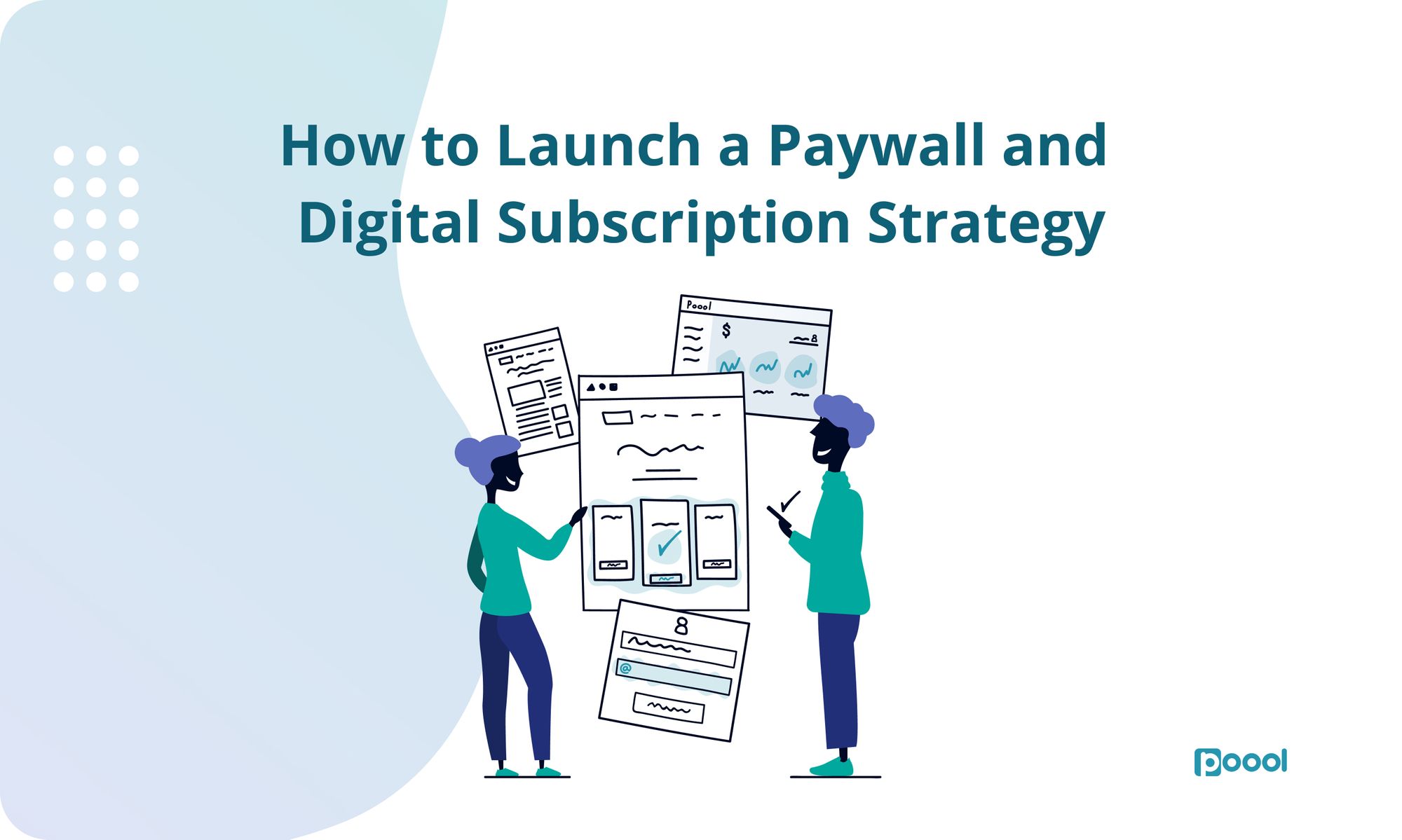Recap and key takeaways from The State of Digital Publishing’s podcast episode with Stéphane Père.
Vahe Arabian runs this podcast, releasing an episode each month, is the founder of State of Digital Publishing and expert in SEO.
Stéphane Pere is the CRO at Poool, The Audience Conversion Platform helping digital publishers to convert their users into consented leads, members and subscribers. Stephane has worked with publishers for close to 20 years, including with Yahoo, Bloomberg TV and The Economist for 12 years, across a variety of roles including sales, innovation, data and advertising.
At the beginning of January we learnt that The Athletic is being sold for $550 million to The New York Times, an acquisition that’s going to be really interesting to see develop over time.
The background:
Founded in 2016, with the goal of providing smarter coverage for die hard fans in sports, The Athletic founders decided that it was time to invest in deep-coverage journalism, bring the community (and the eyeballs) and command a business model around subscription. Firstly, strong journalism, secondly form a community and, finally, monetize through subscriptions.
The Athletic really found a unique, ‘newsworthy’ angle on sports, one that’s not just entertainment but a more profound coverage.
This has allowed them to achieve impressive growth in the past - a clear, well defined value proposition. If they wanted to start broadcasting or moving to another model, they’d have had to compete with so many others (especially with recent moves into sport by big VOD platforms). Their niche positioning has actually been their strength until now.
And this had been successful as far as getting people to subscribe and not relying on advertising, but the challenge is that this is an expensive business to run… In fact, The Athletic has been losing cash for 3 years now.
That’s why now’s the right time for this sale - they’ve been losing money continuously, not just because of their business model but also because of Covid when sports events have been put on hold.
On the other side, you’ve got The New York Times who is profitable, growing in subscription and can afford to make new deals in order to grow faster than they are already.
What about The New York Times then?
NYT has a very successful subscription strategy, in two folds - one is their leading brand doing news coverage, with 5.6 million subscribers, and the other is their verticals. For instance, they have 1.9 million subscribers to cooking, or their crosswords section. And only 800,000 subscribers in print.
The challenge now for NYT is to grow faster. They did such a good job at the start but it’s now going to be harder and harder to grow. That’s why having additional features, products or services to upsell to their existing subscribers, including these new verticals, is maybe going to be the way for growth, rather than getting these new eyeballs.
First they acquired Wire Cutter, which focuses on e-commerce, now The Athletic focusing on sports.
This could be very successful - household budgets are limited and users can’t subscribe to everything. With one subscription to a news publisher, another to a VOD site such as Netflix and audio streaming, that’s already a lot.
So maybe the idea is to sell this new vertical (sports) to their current subscribers so that they increase ARPU.
Or maybe boost the perception of the NYT as an elite publisher, having a strong local, national coverage to add to their already international one.
Alternatively, it’ll perhaps help NYT sell more subscriptions abroad, with anglo-saxon die hard sports fans who have an interest in The Athletic.
Overall, Stephane notes that he believes it’s more about the upsell rather than acquisition.
This is a good trend, involving moving towards sustainable growth, which is important for publishers, especially at the moment. Simply focussing on ‘eyeballs’ hasn’t been paying off lately, relying on advertising is becoming ever more difficult and competition is increasing for a reducing quantity of advertising revenue…
That’s why the niche, subscription models are actually successful right now, despite The Athletics losses.
Vahe: It took NYT about 4 years to fully integrate The Wire Cutter - what will it be like in this instance?
Stéphane: Let’s talk about brand, because I think people buy The NYT for The NYT, for their own way of going about ‘news’, whilst I’m not sure people buy The Athletic for The Athletic, more for the quality (specific) writers and contributors.
Maybe it’s less about merging The Athletic and making the brand disappear but more about bringing the sports contributors, the big names, into the NYT journalism. If they don’t do this, which could be a risk, is that these strong contributors and commentators go and build their own media.
It’s more about the names than the name.
What does the case of The Athletic tell us about publisher’s surval at the moment?
What The Athletic perhaps did well was focus on one thing - subscription. This meant they needed to provide value, have a strong value proposition and clear niche. If they’d have attempted to introduce advertising, paid intelligence or whatever, this could have taken the focus away from their strong value proposition that was so crucial for subscription.
The next question is for the other guys - those who currently depend on advertising alone should seriously consider their value proposition and developing more sustainable, diversified revenue streams.
Two years ago, at the start of the pandemic, digital audiences were booming, having increased by 3 in some countries, whilst revenue decreased by 3. So the old equation that used to prove a success - more eyeballs, more money - is no longer true.
Diversifying revenues is therefore hugely important for publishers who have previously relied on advertising alone. This could certainly be a subscription strategy, but you can’t jump right into this. You first have to develop an engaged, vibrant audience who visits your site on a regular and frequent basis. It’s only after this that you can start offering subscriptions.
ELLE, for instance, offered subscriptions in print but relied on advertising monetization alone for their digital platform. So when they wanted to move to a digital subscription strategy, they first employed soft conversion steps including newsletter registration or a registration wall (account creation) to build a more qualified, repeat audience with the goal of forming habits. .
Once this portfolio has been built, you can introduce so many other things, because registration and conversion into members is beneficial in a wide range of ways - increasing subscription conversion rates, first-party data collection, leads for selling other products and services (for yourself and partners) as well as supporting your advertising revenue stream through identity, targeting and retargeting.
Vahe: Registration clearly has huge benefits as an initial step towards getting more leads, finding new ways of growing your user base and eventually monetizing in other ways including subscription, upselling and advertising. Am I correct in saying that?
Stéphane: Yes definitely. Registration benefits any monetization strategy - including advertising and subscription - but you also have to think of it as a strategy in and of itself, including the registration value proposition…
Why should a reader register? Access to specific content, some exclusive perks/benefits or services, maybe a better user experience, but you have to provide users with something in exchange for creating an account.
Discover 12 ways to convert readers into members here!
What’s the future of digital content then? Are there new trends emerging?
One thing Stephane notes is how other verticals, particularly brands, are moving into digital publishing. They start in advertising, then want to be a storyteller to boost business but then it gradually moves into content creation and marketing. This can then develop into brands becoming publishers themselves. Yes, it’s about reaching consumers in a different way but also to have the ability to create audiences themselves, onces that they can then convert into a marketable pool.
This could be interesting for the future to see if brands start acquiring media as a simpler way of moving into this publishing industry.
But this is certainly what we’re seeing at Poool - when the company started, news publishers and digital magazines were our sole clients, but we’re now seeing new verticals, including e-learning platforms, audio streaming services and certainly brands who are coming to us asking ‘How do I convert audiences into a community who is engaged in my site and content, who can then be marketed to?’
The fact that these brands are talking about integrating registration walls and paywalls means they’re clearly serious about developing their own audiences.
Final take-aways
Establish a clear value proposition as a priority
Secondly, form habits - Do your audiences come to your site on a frequent and regular basis? And how can you improve this? - This is going to be how you maximize the business potential of your audiences.
From these, don’t just focus on one avenue for revenues. Diversify revenue steals, including reaching into advertising, subscription and registration, with registration being the key strategy for allowing you to tap into each of these other streams effectively.
🎤 Watch the full podcast episode here.
You may also be interested in:




